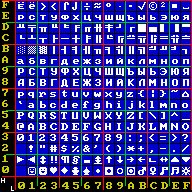Nibble

A nibble (often, nybble) is the computing term for a four-bit aggregation[1], or half an octet (an octet being an 8-bit byte). As a nibble contains 4 bits, there are sixteen (24) possible values, so a nibble corresponds to a single hexadecimal digit (thus, it is often referred to as a "hex digit" or "hexit").
A full byte (octet) is represented by two hexadecimal digits; therefore, it is common to display a byte of information as two nibbles. The nibble is often called a "semioctet" or a "quartet" in a networking or telecommunication context. Sometimes the set of all 256 byte values is represented as a table 16×16, which gives easily readable hexadecimal codes for each value.
The term "nibble" originates from the fact that the term "byte" is a pun on the English word "bite". A nibble is a small bite, which in this context is construed as "half a bite". The alternative spelling "nybble" parallels the spelling of "byte", as noted in editorials in Kilobaud and Byte in the early eighties.[citation needed]
The nibble is used to describe the amount of memory used to store a digit of a number stored in packed decimal format within an IBM mainframe. This technique is used to reduce space requirements, make computations faster, and make debugging easier. An 8-bit byte is split in half and each nibble is used to store one digit. The last nibble of the variable is reserved for the sign. Thus a variable which can store up to nine digits would be "packed" into 5 bytes. Ease of debugging resulted from the numbers being readable in a hex dump where two hex numbers are used to represent the value of a byte, as 16×16 = 28.
Historically, there have been cases where the term "nybble" was used for a set of bits fewer than 8, but not necessarily 4. In the Apple II microcomputer line, much of the disk drive control was implemented in software. Writing data to a disk was done by converting 256-byte pages into sets of 5-bit or, later, 6-bit nibbles; loading data from the disk required the reverse. Note that the term byte also had this ambiguity; at one time, byte meant a set of bits but not necessarily 8. Today, the terms "byte" and "nibble" generally refer to 8- and 4-bit collections, respectively, and are not often used for other sizes.
The sixteen nibbles and their equivalents in other numeral systems:
| 0hex | = | 0dec | = | 0oct | 0 | 0 | 0 | 0 | |||
| 1hex | = | 1dec | = | 1oct | 0 | 0 | 0 | 1 | |||
| 2hex | = | 2dec | = | 2oct | 0 | 0 | 1 | 0 | |||
| 3hex | = | 3dec | = | 3oct | 0 | 0 | 1 | 1 | |||
| 4hex | = | 4dec | = | 4oct | 0 | 1 | 0 | 0 | |||
| 5hex | = | 5dec | = | 5oct | 0 | 1 | 0 | 1 | |||
| 6hex | = | 6dec | = | 6oct | 0 | 1 | 1 | 0 | |||
| 7hex | = | 7dec | = | 7oct | 0 | 1 | 1 | 1 | |||
| 8hex | = | 8dec | = | 10oct | 1 | 0 | 0 | 0 | |||
| 9hex | = | 9dec | = | 11oct | 1 | 0 | 0 | 1 | |||
| Ahex | = | 10dec | = | 12oct | 1 | 0 | 1 | 0 | |||
| Bhex | = | 11dec | = | 13oct | 1 | 0 | 1 | 1 | |||
| Chex | = | 12dec | = | 14oct | 1 | 1 | 0 | 0 | |||
| Dhex | = | 13dec | = | 15oct | 1 | 1 | 0 | 1 | |||
| Ehex | = | 14dec | = | 16oct | 1 | 1 | 1 | 0 | |||
| Fhex | = | 15dec | = | 17oct | 1 | 1 | 1 | 1 | |||
See also
References
- ^ Hall, D. V. (1980). Microprocessors and Digital Systems. McGraw-Hill. ISBN 0-07-025571-7.
{{cite book}}: Cite has empty unknown parameter:|coauthors=(help)
